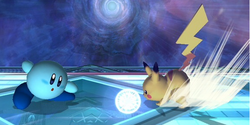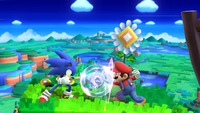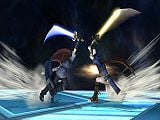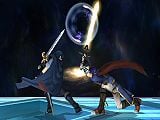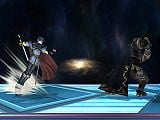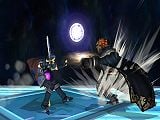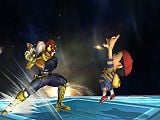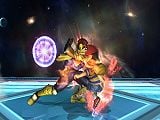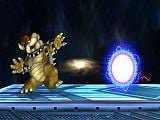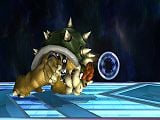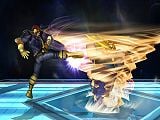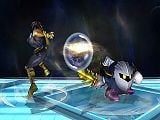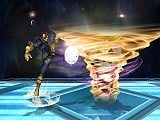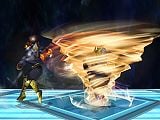Priority: Difference between revisions
0%Kamikazee (talk | contribs) |
SacredFire37 (talk | contribs) m (→Attacks with transcendent priority: Updated so that it shows that zss dash attack is transcendent in all 3 games) Tag: Mobile edit |
||
| Line 697: | Line 697: | ||
|- | |- | ||
|[[Farore's Wind]] | |[[Farore's Wind]] | ||
|{{GameIcon|SSBB}} | |||
|- | |- | ||
|rowspan=2|[[Zero Suit Samus]] | |rowspan=2|[[Zero Suit Samus]] | ||
|Dash attack | |Dash attack | ||
|{{GameIcon|SSBB}}{{GameIcon|SSB4}}{{GameIcon|SSBU}} | |||
|- | |- | ||
|Down smash | |Down smash | ||
Revision as of 11:09, July 19, 2021
Priority is a property of hitboxes in the Super Smash Bros. series that describes their behavior upon interacting with other hitboxes. While the priority of the hitboxes produced by normal ground attacks follows a set of rules that is dependent upon the amount of damage they deal (the law of high and low priority), different rules apply to those of normal aerial attacks, and certain special moves when performed in the air. Furthermore, some hitboxes and attacks, such as shots from Fox's Blaster, possess a special kind of priority called transcendent priority, which ignores the rules of normal priority. Rebound is a term used to describe an animation that occurs when two direct grounded moves with normal priority mechanics are within 9% of each other when they collide. The length of this animation changes based on the damage output of both attacks.
Priority in the Super Smash Bros. series is not to be confused with the general term "priority" that is used to gauge the relative usefulness of a move with regards to its speed, the size or duration of its hitbox, or any other property it might have (e.g. armor or intangibility/invincibility around part of or the entire body). The concept of priority also governs how individual hitboxes and objects react, not attacks as a whole. For example, an attack can be cancelled if its only non-transcendent hitbox is outprioritized, regardless of the status of its other transcendent hitboxes. In addition, attacks being cancelled via priority rules is on a per-object basis, meaning that an attack that is outprioritized can still damage other players or objects if it hits at the same time.
Normal priority
Normal priority describes the set of rules that apply to normal attack hitboxes, that is, any attack hitbox that is not classified as transcendent. As such, the majority of standard attacks, aerials, special attacks, and projectiles contain hitboxes with normal priority.
Ground attacks and projectiles
The hitboxes of normal ground attacks follow the law of high and low priority. This means that they interact with each other in terms of the damage they deal, which in turn classifies each as having "high" or "low" priority. When two ground attack hitboxes overlap, they will collide, and will either cancel each other out, or one will override (out-prioritize) the other. This collision is signified by a white "bubble", and in Melee, a distinct "ting" sound, as if swords are clanging, is also heard. If two actual swords clash, such as Link and Marth's blades, a more realistic "ting" sound is heard. The law of high and low priority functions in terms of a damage (priority) range of 9%. On these terms, one ground attack must deal 9% or more additional damage than another attack if it is to out-prioritize it, hence, the "priority range" in Smash Bros games is 9% (note that in the original Super Smash Bros., the priority range is instead 10%).
If one attack hitbox is above the priority range of another, that is, deals 9% or more than the other, the stronger hitbox out-prioritizes the weaker one, and the weaker attack is cancelled by the stronger one. However, if two colliding ground attack hitboxes are within the priority range, meaning that the difference in damage dealt by the two hitboxes is less than or equal to 9%, they will "clash", and both will cancel out, delivering no damage to either character. Thus, normal attacks with "high" priority are those whose hitboxes deal a large amount of damage, and are therefore more inclined to out-prioritize other attacks, while those with "low" priority deal little damage.
For example:
- In Brawl, if Marth's un-tipped forward smash collides with Ike's forward smash (14% vs. 22%), they will clash and cancel each other out.
- However, if Marth's un-tipped forward smash collides with Ganondorf's forward smash (14% vs. 24%), Ganondorf's forward smash will cancel out (out-prioritise) Marth's forward smash and hit Marth.
- If Captain Falcon's forward smash collides with Ness' up tilt (19% vs. 7%), Captain Falcon's forward smash will out-prioritise Ness' up tilt and hit Ness.
- If Captain Falcon's Falcon Punch collides with Yoshi's Egg Roll (27% vs. 12%), the Falcon Punch will out-prioritise the Egg Roll and hit Yoshi.
The same rules apply when ground attack hitboxes overlap normal projectile hitboxes.
For example:
- Marth's un-tipped forward smash is out-prioritised by Samus' fully charged Charge Shot (14% vs. 25%).
- However, if the second hitbox of Bowser's forward smash collides with Samus' fully charged Charge Shot, they will cancel each other out (23% vs. 25%).
While most normal projectiles follow the rules of ground priority, Snake's Remote Missile, Diddy Kong's Peanut Popgun, and King Dedede's Waddle Dee Toss behave differently. While the 8% range does apply to Dedede's Gordo, its hitbox behaves like an airborne attack as it cannot be cancelled out. For example, if Captain Falcon's forward smash collides with a Gordo (19% vs. 23%), the clash bubble will appear, and the forward smash will be cancelled out while the Gordo is not. However, since both hitboxes are within the priority range, the Gordo will go right through Captain Falcon without harming him, and continue along its natural path. It will, however, still possess its damaging hitboxes, and can still harm any other character it happens to touch along its route.
Snake's Remote Missile has a damagable hitbox and behaves like a thrown item, such as a capsule. Hence, when opposing hitboxes collide with the Remote Missile, they will damage it instead of colliding with it. If the Remote Missile takes enough damage, it will be destroyed. The peanuts from Diddy Kong's Peanut Popgun behave the same way, but any colliding hitbox, even if it only deals 1%, will destroy the peanuts.
Aerial attacks
Different rules apply to the hitboxes of normal aerial attacks. When a normal aerial attack hitbox overlaps that of a normal ground attack or another normal aerial, the attacks cannot collide or clash and the law of high and low priority does not apply. If an overlap between the hitboxes of two such attacks occurs, both will persist, irrespective of each other, and will damage their foes if they contact them.
For example:
- If Sonic's back aerial overlaps Mario's up tilt, neither attack is cancelled, and both characters are hit by each other's attacks.
However, the hitboxes of aerial attacks can collide with normal projectiles, in which case the law of high and low priority functions. However, aerial attack animations cannot be cancelled out, and will continue even if out-prioritised.
For example:
- If Marth's forward aerial collides with Samus' fully charged Charge Shot (10% vs. 25%), his forward aerial will not be cancelled out, but it will fail to cancel out the Charge Shot. As a result, the collision action will occur, but Samus' Charge Shot will out-prioritise the forward aerial and hit Marth.
- However, if Ganondorf's forward aerial collides with Samus' fully charged Charge Shot (17% vs. 25%), his forward aerial will cancel out the Charge Shot and Ganondorf will not be harmed.
Rebound
Rebound refers to the usual outcome when two different hitboxes connect without one having priority over the other. The outcome is the animations of both attacks are interrupted and both fighters are briefly caught in a unique "rebound" animation where neither can perform any action until the animation is finished. The length of the animation increases proportionately to the damage the hitbox would have dealt. This means the fighter that performed the weaker attack would get out of rebound before the other and have frame advantage. The calculation for rebound duration depends on the game, but "R" always means rebound frames and "d" always means damage dealt. In Melee, the calculation is R=6.6+(d*0.558). In Smash 4, the calculation is R=Floor((d*15/8)+7.5).
Exceptions to normal priority
Considered both airborne and grounded
| Character | Move | Games |
|---|---|---|
| Falco | Falco Phantasm | |
| Fox | Fox Illusion | |
| Meta Knight | Mach Tornado (both grounded and airborne) | |
| Drill Rush (both grounded and airborne) | ||
| Glide attack | ||
| Ness | Up smash | |
| Down smash | ||
| Olimar | All Pikmin-based attacks | |
| Zero Suit Samus | Neutral aerial | |
| Up smash* (second hitbox only) |
*The second hitbox of Zero Suit Samus' up smash behaves like an aerial. It may be out-prioritised by another character's aerial, but the up smash's animation and subsequent hitboxes cannot be cancelled.
The hitboxes of the above attacks can collide with the hitboxes of other attacks regardless of if they're ground or aerial attacks. When such a collision occurs, the clash bubble will appear and the outcome will follow the law of high and low priority. However, airborne attacks cannot be cancelled out, including airborne special moves. Thus, while the results of a collision will follow the law of high and low priority, the appearance of such a collision will differ to that of two colliding ground attacks.
If one of the above ground attacks collides with an aerial, or one of the above aerials collides with a ground attack, and the ground attack is below the priority range of the aerial, the ground attack will be cancelled and the airborne attack can damage the wielder of the ground attack. If the two hitboxes are within the priority range, the ground attack will be cancelled out, and, since it is an aerial attack, the animation of the airborne attack will persist. However, the airborne hitbox becomes harmless, and the wielder of the ground attack will not at all be knocked or damaged by the airborne hitbox, regardless of whether it connects or not.
For example:
- If King's Dedede up tilt collides with Meta Knight's glide attack (13% vs. 13%), Dedede's up tilt will be cancelled out, but he will not be harmed, even if the hitbox of Meta Knight's glide attack contacts King Dedede's body.
If the hitbox of a ground attack is above the priority range of a colliding airborne hitbox, both attack animations will persist, but the airborne hitbox will become harmless, while the ground attack is still able to damage. Thus, if the hitbox of the ground attack connects with the body of the character who used the airborne special, this character will take the damage and knockback of the ground attack. A notable example of a special move that can collide with the hitboxes of other attacks while airborne is Meta Knight's Mach Tornado. If performed on the ground (grounded), it can be cancelled out, but if airborne, it cannot be cancelled. Mach Tornado is a multi-hit move that deals 1% per hit during the main portion of the attack.
For example:
- If Captain Falcon's forward tilt collides with a hitbox of Meta Knight's grounded Mach Tornado (10% vs. 1%), the forward tilt will collide with, and cancel out the Mach Tornado.
- If the Mach Tornado is airborne, Captain Falcon's forward tilt can cancel one of its hitboxes, but cannot cancel the hitboxes that follow. Mach Tornado cannot cancel his forward tilt either, because it is too weak (10% vs. 1%). However, unless the hitbox of Captain Falcon's forward tilt connects with Meta Knight's body, the Mach Tornado will continue and can afterwards damage Captain Falcon, despite the fact that his forward tilt out-prioritised it.
Moves that cannot rebound
Some attacks cannot rebound after colliding with an attack within the priority range (also known as trampling); in other words, they will continue their animations as if they did not collide at all, but both hitboxes still cancel each other out if they are within the 9% range. This can be advantageous for moves with this property that are either multihitting in nature, very fast, or very damaging (which would increase the length and therefore vulnerability of the rebounding animation), but is disadvantageous if the move's endlag is longer than the length of the opponent's rebounding animation. Additionally, two moves that cannot rebound that are used against each other are more prone to damaging both characters instead of cancelling out their hitboxes.
Strangely in Brawl, the hitbox flag which should determine whether a move can rebound or not is discarded as soon as the hitbox is generated. This means that moves in Brawl which are not supposed to rebound (such as Jigglypuff's dash attack) will rebound anyway. This was most likely a coding error.
| Character | Move | Games |
|---|---|---|
| Bayonetta | All smash attacks (except the aerial-only hitbox in Ultimate) | |
| Bowser | Forward smash (late) | |
| Up smash (first hit only) | ||
| Cloud | Limit Break Cross Slash | |
| Climhazzard (regular and Limit Break version, first hit only) | ||
| Finishing Touch | ||
| Falco | Forward smash | |
| Falco Phantasm | ||
| Fox | Forward smash | |
| Fox Illusion | ||
| Hero | Forward tilt (hit 1) | |
| Ike | Dash attack (early) | |
| Jigglypuff | Dash attack | |
| Little Mac | Neutral attack | |
| All tilt attacks | ||
| Lucario | Force Palm (projectile portion) | |
| Mewtwo | Neutral attack (infinite) | |
| Mii Brawler | Shot Put | |
| Mii Swordfighter | Gale Strike | |
| Palutena | All tilt attacks | |
| Richter | Forward tilt | |
| Ryu | Forward tilt (held, both hits) | |
| Tatsumaki Senpukyaku (all versions) | ||
| Focus Attack (arm hitbox) | ||
| Simon | Forward tilt | |
| Zero Suit Samus | Up tilt (both hits) | |
| Zelda | Farore's Wind (first hit, grounded) |
* Should not rebound but rebounds anyway, due to the anti-rebound flag not working properly in Brawl.
** Does not rebound in later games, but the effect is nullified by the move gaining transcendent priority.
Non-character objects with complex animations
A select few attacks in SSB4 will collide with other attacks, but can only nullify projectiles within the 9% range and will always lose a trade with regular hitboxes regardless of the 9% rule, much like a grab. For example, Bayonetta's up smash cannot be used as effectively as other up smashes to hit opponents in the air, as any hitbox that comes into contact with it will render the up smash inert, and if the hitbox is close enough to Bayonetta at the moment of colliding, only Bayonetta will take damage. However, if the opposing hitbox is a projectile or another attack with this property (i.e. Lucario's Aura Sphere or another Bayonetta's up smash), both characters will take damage as if one of them used an aerial hitbox (but the collision bubble will still appear). The overarching pattern among these attacks is that they are character-specific props that feature complex animations beyond simply moving or rotating, and thus it is possible (but not proven) that the game short-sightedly does not attempt to make them capable of trading with attacks from other animating elements (i.e. characters).
Because they cannot override regular hitboxes and it is not always clear to players whether a hitbox is attached to a character or a prop, these attacks are often perceived as having "low priority", and some moveset repositories such as Kurogane Hammer list them under such term.
| Character | Move | Games |
|---|---|---|
| Bayonetta | All smash attacks (except for first hit of down smash) | |
| Corrin | Forward smash (non-charging portion) | |
| Dragon Fang Shot (both portions) | ||
| Dragon Lunge (initial lunge only) | ||
| Olimar | All Pikmin-based attacks | |
| Villager | Timber (tree hitboxes only, both sprouting and falling) |
Transcendent priority
Transcendent priority (also known as transcending priority) refers to hitboxes that cannot clang with other hitboxes, meaning they won't cancel out, or be cancelled out by, other hitboxes, even other transcendent hitboxes. Transcendent hitboxes will always win exchanges, but are more likely to trade hits and are unable to cancel out projectiles. In Smash 64, transcendent priority only existed for certain projectiles (such as Fox's Blaster) but from Melee onward, it could exist for any kind of attack.
For example:
- Brawl Meta Knight's forward smash is transcendent. If a pair of Meta Knights use their forward smash at the same time, and the forward smash hitboxes overlap each other, they will not collide, and their animations and damaging properties will continue until the attack ends naturally. If the two Meta Knights are close enough together, each will be hit by the other's forward smash.
- Lucas' forward smash is transcendent. If Donkey Kong's forward smash overlaps with Lucas' forward smash (20% vs. 15%), Lucas' forward smash will go through Donkey Kong's without colliding. If its hitboxes touch Donkey Kong, he will receive damage and knockback from Lucas' forward smash, while Lucas will be hit by Donkey Kong's forward smash as well since normal hitboxes will go through transcendent hitboxes.
- As of version 9.0.0, many rapid jabs and their finishers in Ultimate are transcendent. This is to ensure that the final hit will connect without the fear of an opponent canceling the move with their own jab.
Attacks with transcendent priority
| Character | Move | Games |
|---|---|---|
| Banjo & Kazooie | Rapid jab finisher | |
| Bayonetta | Heel Slide and After Burner Kick | |
| Bullet Arts on all applicable moves | ||
| Rapid jab finisher | ||
| All smash attacks (aerial-only hitbox) | ||
| Bowser | Fire Breath | |
| Koopa Klaw (the attack hitbox, not the grab) | ||
| Fire Shot | ||
| Captain Falcon | Falcon Punch | |
| Charizard | Up smash | |
| Chrom | Flare Blade | |
| Double-Edge Dance | ||
| Cloud | Limit Break Blade Beam | |
| Corrin | Forward smash (charging portion) | |
| Diddy Kong | Dash attack | |
| Banana Peel | ||
| Donkey Kong | Hand Slap | |
| Dr. Mario | Forward smash (sweetspot only) | |
| Super Sheet | ||
| Dr. Tornado (all hitboxes except the final hit in Melee, only the final hit in Smash 4) | ||
| Falco | Blaster | |
| Reflector | ||
| Fox | Blaster | |
| Fox Illusion (only when airborne) | ||
| Ganondorf | Down aerial | |
| Warlock Blade | ||
| Warlock Thrust (sourspot only) | ||
| Hero | Zap / Zapple / Kazap | |
| Ice Climbers | Squall Hammer | |
| Blizzard | ||
| Ike | Up smash | |
| Down smash | ||
| All aerial attacks | ||
| Eruption | ||
| Aether (all hitboxes except the initial one in Brawl, all hitboxes in SSB4 and Ultimate) | ||
| Incineroar | Darkest Lariat | |
| Ivysaur | Neutral attack | |
| Bullet Seed | ||
| Rapid jab finisher | ||
| Joker | Gun / Gun Special | |
| King Dedede | All smash attacks | |
| Neutral aerial | ||
| Super Dedede Jump | ||
| Jet Hammer | ||
| Kirby | Dash attack | |
| Hammer (grounded only in Melee, grounded and aerial from Brawl onwards) | ||
| Final Cutter (projectile only in Melee, sword strike and projectile from Brawl onwards) | ||
| Link | Grab aerial | |
| Spin Attack (only initial hitbox for grounded version from Brawl onwards) | ||
| Lucario | Forward smash (sweetspot only in Brawl, late hitbox only in Smash 4) | |
| Aura Sphere (charging hitbox) | ||
| Force Palm (projectile portion) | ||
| Lucas | Forward smash | |
| Down smash | ||
| Neutral aerial | ||
| Back aerial (sweetspot only) | ||
| PK Freeze | ||
| PSI Magnet | ||
| Lucina | Shield Breaker | |
| Dancing Blade | ||
| Dolphin Slash | ||
| Mario | Forward smash (sweetspot only) | |
| Cape | ||
| Mario Tornado | ||
| Marth | Shield Breaker | |
| Dancing Blade | ||
| Dolphin Slash | ||
| Meta Knight | All standard attacks except dash attack, glide attack, and floor attack (trip) | |
| Shuttle Loop | ||
| Dimensional Cape | ||
| Rapid jab finisher | ||
| Mewtwo | Forward smash (sweetspot only) | |
| Down smash | ||
| Disable | ||
| Mii Gunner | Forward aerial | |
| Laser Blaze | ||
| Up aerial | ||
| Forward smash | ||
| Min Min | Rapid jab finisher | |
| Mr. Game & Watch | Chef (frying pan hitbox) | |
| Mythra | Lightning Buster | |
| Photon Edge | ||
| Ness | Dash attack | |
| PK Flash | ||
| PK Thunder (projectile only) | ||
| Olimar | Down smash (sweetspot only) | |
| Palutena | All smash attacks | |
| Down aerial | ||
| Peach | Up tilt | |
| Up smash (sourspot only) | ||
| Pichu | Forward smash | |
| Thunder | ||
| Pikachu | Neutral attack | |
| Forward smash (sweetspot only in Brawl) | ||
| Up smash (late hitbox only) | ||
| Down smash | ||
| Thunder | ||
| Piranha Plant | Ptooie | |
| Rapid jab | ||
| Rapid jab finisher | ||
| Pyra | Flame Nova (final hit only) | |
| Richter | Rapid jab | |
| Rapid jab finisher | ||
| Ridley | Forward smash | |
| Rapid jab | ||
| Rapid jab finisher | ||
| R.O.B. | Robo Beam | |
| Arm Rotor | ||
| Robin | Rapid jab finisher | |
| Roy | Flare Blade | |
| Double-Edge Dance | ||
| Blazer | ||
| Ryu | Shoryuken (all versions) | |
| Focus Attack (fist hitbox only) | ||
| Samus | Grab aerial | |
| Sheik | Needle Storm | |
| Chain | ||
| Vanish | ||
| Bouncing Fish | ||
| Shulk | Up smash | |
| Simon | Rapid jab | |
| Rapid jab finisher | ||
| Snake | Forward smash | |
| Squirtle | Up smash | |
| Sonic | Neutral aerial | |
| Terry | Burning Knuckle / Crack Shoot | |
| Toon Link | Spin Attack | |
| Wario | Forward smash | |
| Down aerial (final hit only) | ||
| Wario Waft | ||
| Wolf | Blaster | |
| Young Link | Grab aerial | |
| Spin Attack (airborne only) | ||
| Rapid jab finisher | ||
| Zelda | Neutral attack | |
| Forward tilt | ||
| Up tilt | ||
| Dash attack | ||
| Forward smash | ||
| Up smash (except final hitbox) | ||
| Down smash | ||
| Neutral aerial | ||
| Forward aerial (sweetspot only in Smash 4) | ||
| Back aerial (sweetspot only in Smash 4) | ||
| Up aerial | ||
| Down aerial (sourspot only) | ||
| Nayru's Love | ||
| Din's Fire | ||
| Farore's Wind | ||
| Zero Suit Samus | Dash attack | |
| Down smash |
Gallery
Trivia
- In Melee and Ultimate, a unique metallic sound effect can be heard when hitboxes with a slash effect clang with each other.
